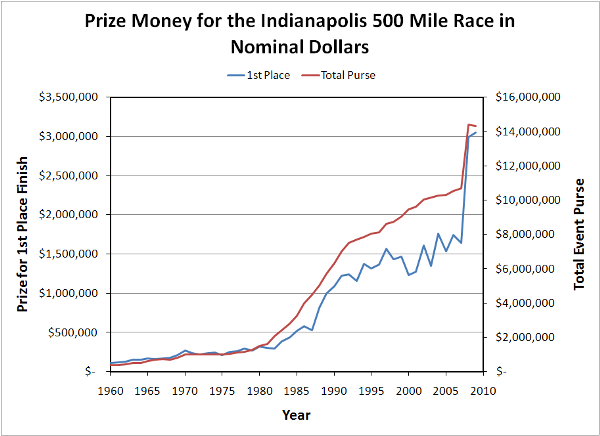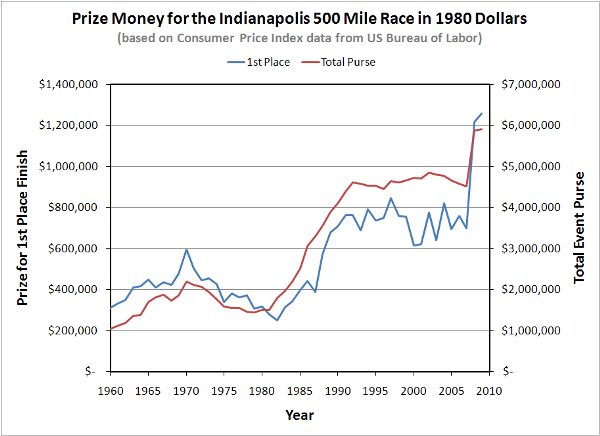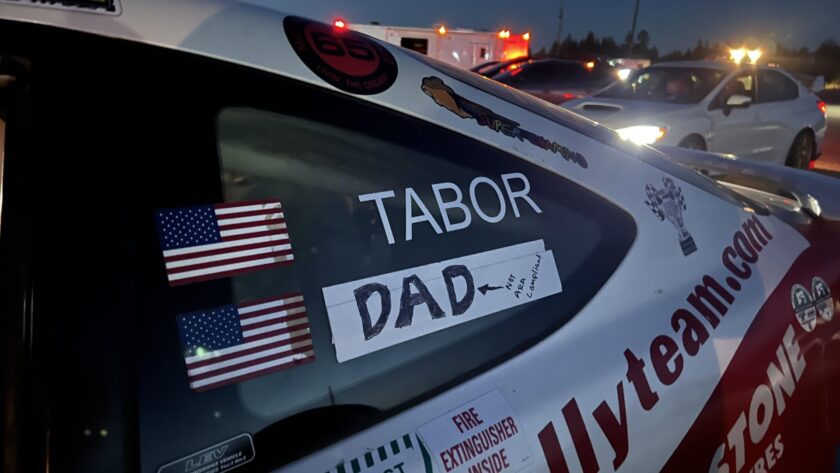Rebuilding the Indianapolis 500 Mile Race
Show Me The Money!
During the 1950’s and 60’s, the Indianapolis 500 Mile Race saw tremendous growth. There are multiple reasons for this, of course, but one part of this was the continuing increase in prize money offered for the event. From 1950 to 1970, the total event purse experiences a five-fold increase! Even accounting for inflation, the purse increased three-fold. Say what you will about teams and drivers competing for the “love of the sport”, if the money isn’t there, the top talent won’t be there either. During the 1970s, Indianapolis was still popular, primarily because of the new car designs that were coming out, and the popularity of larger-than-life drivers like AJ Foyt and Mario Andretti. The 1980’s and early 1990’s saw a resurgent growth of the sport. This corresponds directly to a time, 1980 to 1992, during which the total purse size increased again by five times, three times in inflation-adjusted dollars. Offering a seriously valuable prize brings out the best of competitors from around the world. This is what has been lacking in recent years. Since 1992, the total purse and the cash award for the race winner have remained flat when adjusted for inflation. During this time, the interest from both fans and competitors has waned. Yes, there were some other things going on as well, but beginning with the 2000 race, all open-wheel teams were welcome to compete in the 500, so I discount The Split as affecting the number of potential competitors interested in the event. It did affect the prestige of the event and therefore the amount of sponsorship money the Speedway was able to put towards the event purse.


What’s the point of all this? The point is Money=Interest both from fans and from competitors. If the Indianapolis 500 is going to be the preeminent motorsports event in the world, it must offer a purse commensurate with that prestige. The league significantly increased the purse in 2008, both the winner’s prize and total event purse increased by roughly 50%, and participation in the 2009 event reflected that increase. Qualification and Race Day attendances were up as compared to previous years in the past decade. I know, one data point does not a trend make, but there’s no mistaking that the popularity of the 500 increased during those periods of time in which the purse increased. There’s no reason not to expect the same corellation today.
The recent signing of IZOD as the title sponsor of the IndyCar Series is a huge boost for the league and will hopefully encourage other sponsors to invest in the series and specifically in the 500. This will allow the league to continue to grow the total event purse and therefore increase the drawing power of the event. In the end, it really is all about the money. As much as we might like to think of our sport in more idealistic it’s-about-the-competition type of way, we have to admit that without the money there is no competition. The corollary to that is that the more money is up for grabs, the more competition there will be. The league has taken the right steps regarding this, and with more business partners coming on board, it should be easier, although certainly not easy, to continue this growth. If the league allows the purse sizes to flatten once again, there will be a corresponding stall in the growth of the Indianapolis 500 and of the IndyCar Series.
Conclusions
In these past five articles, I’ve mentioned a lot of things that I’d like to see changed about the Indianapolis 500 Mile Race. These changes of course come from the very selfish point of view of my wanting a great and majestic open-wheel race in the Heart of America, and in a region central to the early development of the automotive industry that is the absolute envy of the motorsports world. I want to be able to go and share that experience with a hundred thousand of my best mates on Pole Day and Bump Day, and to sit cheek-to-jowl with my other 400,000 best friends in the world every glorious month of May. For that to happen, the event needs to change and become far more than just another IndyCar race. It will take the following:
- A good and solid standard tub and safety regs so that we can keep our heroes with us and watch them grow old and mentor our new and future heroes.
- Very open engine and chassis rules to encourage teams and manufacturers to push the limits of what can be done and to generate excitement amongst us fans. What are we going to see this year? Who’s going to get it right? Who’s going to get it wrong?
- We need to have the possibility of hearing those magical words, “It’s a new track record,” announced over the PA. We don’t just want to see history at the IMS Museum, we want to see history made on the track!
- Lastly, all of the above will generate viewership and fan interest which WILL bring the sponsors. Companies want their ads where there are eyeballs to see them. This money needs to be reinvested, in part, into the event purse, making it large enough that everyone in the motorsports world sits up and takes notice!
If things continue under the current status-quo, the event will never score more viewership than it gets now, and will likely decline. The increase in attendance recently is good to see, but it’s not sustainable with the current system of using a single chassis with a single engine running at speeds that don’t compare to what we could see 20 years ago. I understand that this won’t happen overnight, nor should it. Rebuilding the Indianapolis 500 Mile Race will take some time, but the sooner we start, the sooner Indianapolis will once again be the Mecca of Motorsports.



